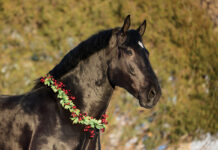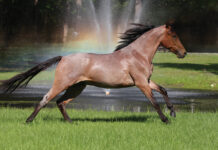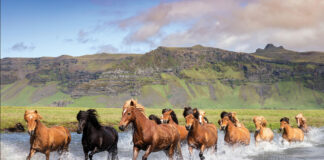What if you don’t want to ride but you still want to be an equestrian? You probably don’t need, or want, a large horse (read: money muncher). But you still want the versatility to compete and maybe drive, right? Then the Shetland Pony might have something to offer you.

Keeping Tradition Alive
With a height limit of 46 inches at the withers, these Shetlands are stocky but staunch. Coupled with a steady temperament and a willing, go-getter attitude, the traditional Shetland Pony makes a great partner for driving or in-hand activities. And if you’re looking to get your kids involved in the horse world, the Shetland makes a great introduction to riding and in-hand work for young equestrians.

These are qualities that drew Ami Howard of Olney Farm to the Shetland Pony. “Handled correctly, they are kid-friendly, safe, quiet, athletic, healthy ponies for kids—and adults. They are suited to all equestrian disciplines—they’re just smaller.”
Olney Farm has been breeding Shetland Ponies since 1926, when Howard’s mother-in-law began producing them for her lesson program. They are still employed in the farm’s lesson program today for 3- to 9-year-old children, as well as for teaching adults how to drive.
“Our Shetlands are very close to the British Shetland and not to the American Shetland,” says Howard. “The disposition of the British Shetland is pretty unflappable, which is why they are good for small beginners: not spooky; steady and reliable.”
Howard says that Shetlands have plenty of personality and a sense of humor to keep you entertained, but she cautions that they require an experienced horse person to get their training started. “They are quick to learn both good and bad habits,” she explains.
Just Your Type
If you want a sleek, fancy show pony, or one with an elegant, refined look but requiring less of the upkeep that top competition demands, the American Shetland Pony Club has four types of ponies to choose from.
The foundation pony is the stocky, short-legged but sturdy companion reminiscent of the ponies from the 1950s that Americans selectively bred from the original British ponies. The foundation ponies stand 42 inches and under, and are smaller and bigger-boned than the next type of pony, the classic.

The classic American Shetland is a slightly more refined version of the traditional British and foundation American Shetlands, but with a little more substance than the ultra-refined modern Shetland. Classic Shetlands can be no taller than 46 inches. Those on the taller end of the spectrum make suitable starter ponies for children. From halter and under-saddle classes to driving and even therapeutic riding, classic Shetlands can serve many different roles.
For the serious competitor, the modern Shetland is the ultimate show pony—sleek and refined with animated movement. Often seen in roadster, fine harness and pleasure driving classes, they’re also fitting show companions for youth competitors in liberty classes such as costume, in-hand obstacle and the in-hand pony jumper division.

If you like the look of the modern Shetland Pony but aren’t interested in all the hard work that goes into maintaining a show pony, the modern pleasure pony is your best bet. Not quite as animated in motion as the modern Shetland, the modern pleasure type is shown in classes that focus on manners, including halter and driving.
In addition to the variety of types and versatility, as ponies, Shetlands are hardy, easy keepers that won’t eat too much greenery (i.e. your hard-earned money)!
To find out whether a Shetland is the right companion for you, visit the American Shetland Pony Club at www.shetlandminiature.com, or the Shetland Pony Society of North America at www.shetlandponysociety.com.
This article originally appeared in the March 2016 issue of Horse Illustrated magazine. Click here to subscribe!






Great article! Thanks for covering the wonderful Shetland Pony breed. We’ve had Shetlands for over 50 years and we are still raising a few and going to pony shows! Keeps you young!!
Great article with references to http://www.shetlandminiature.com Thank you for promoting an awesome breed!!